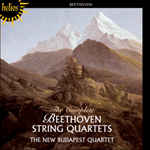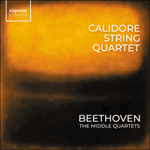
Welcome to Hyperion Records, a British classical label devoted to presenting high-quality recordings of music of all styles and from all periods from the twelfth century to the twenty-first.
Hyperion offers both CDs, and downloads in a number of formats. The site is also available in several languages.
Please use the dropdown buttons to set your preferred options, or use the checkbox to accept the defaults.

| Calidore String Quartet» More |
Germane to the work as a whole is the chord of the diminished seventh (three minor thirds on top of each other). This is the most famously ambiguous chord in music — someone called it the Clapham Junction of music because you can go almost anywhere from it. It pervades the strange searching introduction, where it receives cryptically exhaustive treatment. Beethoven was dismissive of its too frequent use — by Weber, for instance — but here he explores in it mysteries undreamed of by any other composer. It gives way to the very bright C major Allegro — but in that, too, we find the diminished seventh has a role. Notice the successive entries of the instruments at the recapitulation, on successive notes of the chord. The development has at its heart a magnificent repudiation of this chromaticism, the first two notes of the movement transformed into a mighty song of mountain air. But far from dispelling the mystery, it heightens it.
The A minor second movement is unique in Beethoven, who wrote nothing else like it. Like the introduction to the Quartet, it has a fixation, but on themes as well as harmony. In rhythm it is also obsessive and there is a fateful fascination about it. The design is also unusual, a sonata form with reversed recapitulation, making a point of the polar opposition of the tritone A and E flat (the diminished seventh consists of two overlapping tritones!).
After this the C major Minuet is a period of repose, a soothing influence, switching on normal light. It is beautifully composed, concealing the skill of its smooth counterpoint. The Trio is more lively and homophonic, in the key of F.
A link leads straight into the tumultuous finale, beginning with the fieriest fugato Beethoven had yet conceived. Defiance and energy are shot through the music from start to finish, in what is to date the greatest of Beethoven's finales. If you listen acutely you will hear an anticipation of Egmont in it (the coda of the Overture).
from notes by Robert Simpson © 1991
L'accord de septième diminuée (trois tierces mineures une au-dessus de l'autre) est lié à l'ouvrage entier. Cet accord a la réputation d'être le plus ambigu de la musique — il a même été appelé 'la plaque tournante' de la musique, car il est un point de départ dans presque toutes les directions. Il pénètre l'introduction étrangement fouillée où il reçoit un traitement énigmatiquement approfondi. Beethoven rejetait son usage trop fréquent — par Weber, par exemple — mais ici, il y explore des mystères auxquels nul autre compositeur n'a jamais songé. Vient ensuite le très lumineux adagio en ut majeur, mais ici encore la septième diminuée a son rôle. Remarquez l'entrée successive des instruments à la récapitulation, sur les notes successives de l'accord. On trouve au coeur du développement une magnifique répudiation de ce chromaticisme, avec les deux premières notes de ce mouvement transformées en un magnifique air de montagne. Mais loin de dissiper le mystère, cela ne fait que l'intensifier.
Le second mouvement en la mineur est unique chez Beethoven, qui n'a rien écrit de semblable. Tout comme l'introduction au quatuor, il a une fixation, mais sur des themes aussi bien que sur l'harmonie. En rythmes il est aussi obsédant et cela lui donne une fascination prophétique. Le plan lui-même est inhabituel, une forme de sonate avec récapitulation inversée soulignant l'opposition polaire du triton la et mi bémol (la septième diminuée consiste en deux tritons se chevauchant!).
Après cela, le menuet en ut majeur est une période de repos, une influence de douceur, un retour à la lumière normale. Il est d'une très belle composition, dissimulant la technique de son contrepoint sans à-coup. Le trio est plus vivant et homophonique, dans le ton de fa.
Un enchaînement mène tout droit au tumultueux finale, qui débute par le plus ardent fugato jamais conçu par Beethoven. La musique projette défiance et énergie du commencement à la fin, dans ce qui est encore le plus magnifique des finales de Beethoven. En écoutant intensément, vous pourrez y entendre une anticipation d'Egmont (la coda de l'ouverture).
extrait des notes rédigées par Robert Simpson © 1991
Français: Alain Midoux
Geprägt wird das Werk insgesamt durch den verminderten Septakkord (drei kleine Terzen übereinander). Dies ist der berühmteste doppelsinnige Akkord in der Musik —jemand hat ihn nach einem berüchtigten Londoner Eisenbahnknotenpunkt 'Clapham Junction der Musik' genannt, weil man von ihm aus beinahe überall hin kann. Er durchdringt die seltsam unsichere Introduktion, wo er auf rätselhafte Weise erschöpfend behandelt wird. Dabei hatte sich Beethoven gegen seine allzu häufige Verwendung ausgesprochen — zum Beispiel durch Weber. Hier jedoch entdeckt er in ihm Mysterien, die sich kein anderer Komponist träumen ließe. Dann folgt das überschäumend fröhliche Allegro in C-Dur — aber auch hier, stellen wir fest, kommt dem verminderten Septakkord eine Rolle zu. Zum Beispiel fallt auf, daß in der Reprise die Instrumente nacheinander einsetzen, mit aufeinanderfolgenden Noten des Akkords. Im Mittelpunkt der Durchführung steht eine gelungene Zurückweisung dieser Chromatik, indem sie die ersten zwei Noten des Satzes in ein machtvolles Lied verwandelt. Doch statt das Mysterium aufzuheben, wird es nur noch verstärkt.
Der 2. Satz in a-Moll ist einmalig für Beethoven, der so etwas nie wieder geschrieben hat. Wie die Introduktion des Quartetts hat er eine Fixierung, jedoch nicht nur auf Harmonien, sondern auch auf Themen. Außerdem wirkt sein Rhythmus zwanghaft und strahlt eine verhängnisvolle Faszination aus. Sein Aufbau ist ebenfalls ungewöhnlich, eine Sonatensatzform mit umgekehrter Reprise, die den polaren Gegensatz des Tritonus A und Es auseinandersetzt (der verminderte Septakkord besteht aus zwei überlappenden Tritonus-Intervallen!).
Hierauf erscheint das Menuett in C-Dur als Ruhepause, als lindernder Einfluß, als das Einschalten normaler Beleuchtung. Es ist wunderschön gefaßt und verschleiert die Kunstfertigkeit seines fließenden Kontrapunkts. Das Trio ist lebhafter und homophoner und steht in F-Dur.
Eine Überleitung fuhrt direkt ins turbulente Finale. Es setzt mit dem feurigsten Fugato ein, das Beethoven bis dahin komponiert hatte. Trotz und Tatkraft werden der Musik von Anfang bis Ende immer wieder eingegeben, so daß das bislang bedeutendste aller Beethoven-Finales entsteht. Wenn man genau hinhört, entdeckt man darin einen Vorgeschmack auf Egmont (die Coda der Ouvertüre).
aus dem Begleittext von Robert Simpson © 1991
Deutsch: Anne Steeb/Bernd Müller
 Beethoven: String Quartets Beethoven: String Quartets‘Fine performances, always intelligent, with many considerable insights … perfect intonation and excellent ensemble and tonal blend, with first-c ... ‘Very fine … I enjoyed these performances because they deliver Beethoven as I want him, free of the biographical sensationalism. Highly recommend ...» More |
 Beethoven: The middle quartets Beethoven: The middle quartetsFive glorious string quartets dating from late in Beethoven's prodigious 'middle' period: the three 'Rasumovskys' from 1806, Op 74 from 1809 and from the following year Op 95, one of the most extraordinary distillations of musical thought. These ...» More |

